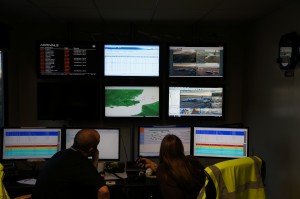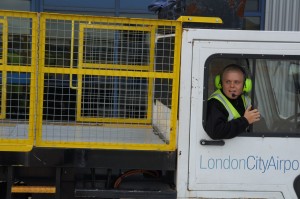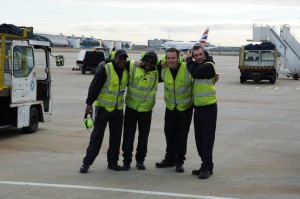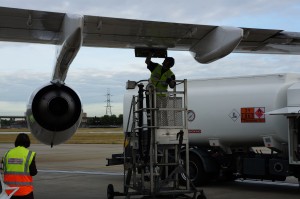Whilst it was still dark we went to a small room at the end of the runway, past doors for crew briefings, to one of the places that must impact on almost everyone that works at the airport or travels there – Ramp Control.
United Airlines sometimes still has Channel 9 on its planes where you can listen in to Air Traffic Control and you can often hear the pilots talking to the Ramp. Usually issues about bags, or fueling, nothing too big or major I thought.
Well I have to say that the team at London City’s Ramp Control must have their fingers in almost every pie on the airport. Their forecasts determine how many staff are needed – for security and catering, as baggage handlers and cleaners for every hour of the working day. All based on projections updated and reviewed daily, but produced the Ramp Team.
There were a team of 4 when I was there last week, two working the computers, TV screens, radios and telephones and the other two responsible for planning and reporting. Most of them had worked in other jobs at the airport before joining Ramp Control. These members of the team admitted that they had no idea how influential Ramp Control was when they worked in other teams.
The team have a whole bank of screens – the familiar arrivals and departures board we all know, and also radar showing the position of their arrivals in the skies over southern England and the Channel. They had CCTV of the Ramps to show what was going on where – who was servicing which aircraft? Were passengers being loaded? Were the bags on or off?
In addition the team have access to a huge, for the want of a better work, spreadsheet. This shows every flight expected on a given day, which stand it is expected to occupy and how long it is likely to be there. Of course, as we all know in aviation, the best laid plans often go wrong.
On the day I visited nothing was going wrong and the team were calmly allocating aircraft to stands so as to maximise efficiency, reduce busing of passengers (great!) and then (oddly) to share out the work between teams.
I had never really thought about this too much – but turnaround times can be impacted by how tired the baggage handlers are! Because of the size of plane accepted at LCY, baggage in loaded and unloaded by hand. I had not realised but LCY has teams of staff working in groups handling a number of gates – three teams handle adjacent gates. This means that in the planning and on the day, the Ramp team have to allocate the arriving and departing flights between teams so that none of them get too tired and slow down in the work. This is more complex than it sounds – busy business flights generate less bags than a quiet ski destination flight where everyone has a bag for their clothes, another for their boots and a third for their skis! SLA’s for turnarounds are measured and a delay through baggage handling can impact the Ramp Team’s work. They even told me that the fitting of the cages to the baggage vehicles has had the effect of adding a minute to the time it takes to fill a cart. That’s how closely this stuff is measured.
There is a considerable amount of planning that goes in to working out where to park aircraft as flights change, aircraft types change, flights are cancelled for holiday periods or new routes start.
The job of the Ramp Team is so much more complex that I had thought – they provide a vital planning resource for the airport – and they team members have worked in real operational areas of the airport, enabling them to have a significant insight in to the impact of their decisions.
Come back tomorrow for the third installment – Part 3 – ATC – How many planes are there above us?







[…] London City – Part 2 – Ramp Control – a tale of skis and teams […]